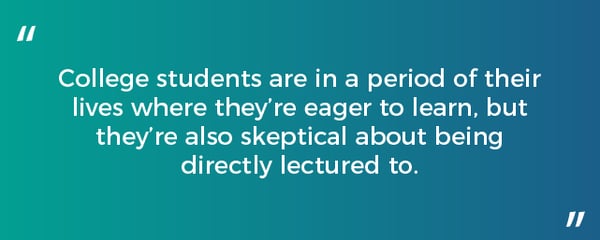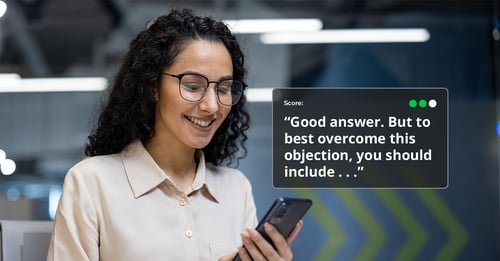Do you need to create an educational video that will be engaging enough to capture the imaginations of busy college students? Are you capable of creating an outstanding video that walks your students step-by-step through your curriculum? Success starts with having an excellent script.
College students are very media savvy and are also heavily targeted by marketers all over the world. They’re used to seeing sophisticated messages. If yours doesn’t resonate, they’ll quickly tune it out and go back to watching TikTok and YouTube videos.
Let’s look at 6 tips for creating an engaging educational video script that’s the perfect fit for college students.
1. Do Your Research
First, consider that not all college students can be painted with the same stereotypical brush. If your target audience is simply “college students”, you’re thinking too broadly. Zoom in.
Will your educational video be viewed by business students? Art students? Are they full-time or part-time? What kind of life concerns and day-to-day learning challenges do they face?
The more you know about your audience, the better your video will target them. You don’t want just a good script; you want a great script. Learn as much as you can about them in advance. For example, you could reach out to the university’s student services director and discuss how to better meet the needs of their students.
2. Decide on a Key Takeaway
It’s important to develop a script that has a narrow educational focus. Educational videos work best for memory retention when they focus on 1 to 3 key takeaways - the primary things you want your audience to remember. These should be your core learning objectives.
Research shows that the average college student can focus intently on a message for a maximum of about 10 to 15 minutes before their attention begins to wane. In fact, their attention will falter even faster if the environment is too distracting or the video is too boring.
Keep this in mind while creating your video script. You’ll have a short time to make your primary points, and those key points should be few in number and easy to remember.
Then, simply start writing. You can explore available video script templates online or from other sources. If another professor has experienced success in this realm, you can ask to borrow their script. Read it out loud and imagine what it would sound like once it was brought to life.
A lot can also be improved during the editing process. You might notice that you get into an analogy or tangent that is not really necessary to get your point across. You can erase some of this information from your script template. You will probably need to create and recreate your script several times before you are happy with the final result.

3. Explore Message Variety
College students are in a period of their lives where they’re eager to learn, but they’re also skeptical about being directly lectured to. Instead, they prefer friendly, helpful messages that show understanding about their place in the world.
Colleges and universities themselves have done extensive research on how to connect with students using educational messages. Here are some tips from a small university that boosted its applicants by 22% simply by creating better video campaigns with more variety:
- Feature diverse people and tell stories from around the world.
- Micro-target your messages to precise college groups.
- Focus on the future, not on the past.
- Be funny and entertaining, within the bounds of an educational video.
- Use relatable language that feels authentic for the age group.
- Be bold and daring, with unique and unexpected perspectives.
Consider using some of these approaches to connect with your target audience.
4. Expand Beyond the Screen
Let’s take a closer look at that last point in the list above: using unexpected perspectives. Video allows a huge amount of creative flexibility in creating educational messages that show engaging perspectives.
You could develop a script for an animated video or one that features 3D motion graphics. Create a concise instructional video or explainer video that features engaging animation to capture the eye of the viewer.
Show a cross-section or give a peek at the interior of tiny spaces that are usually invisible to the human eye. Drone videography has also opened a new way to share a bird’s eye view. Consider how visual and audio graphics and sounds will play out during the production process.
You can also expand your message beyond the screen by inviting students to continue exploring after the class. Provide social media connections and invite them to watch more videos on YouTube later. This makes your message more relatable and shareable.
5. Test Your Script With College Students
Before your script gets too far into pre-production, test it out with college students first. Ask them for honest feedback about the script’s humor, language, and how well it keeps their attention. Consider whether the script is a good idea and shows expertise regarding the subject matter. Incorporate their feedback into revisions.
Also, consider doing a table reading—a live run-through that practices the timing of your video. Don’t be afraid that it will squelch the spontaneity. Great educational videos are well-rehearsed and planned, with professional production quality that adds just the right amount of magic. Also, reading the script out loud can help determine if your jokes don’t land or if there are mistakes in the writing. It’s a lot better to know what doesn’t work before you publicly release your video rather than trying to correct it after the fact.
6. Be Conversational
Remember that you do not want to come off as an obtuse professor in a lecture hall. You are trying to connect with your students and deliver video content that resonates with them. Use conversational language that is targeted at college students and the particular type of college students you are addressing. When you use the same language that your students use to speak, they are more likely to be connected to it. Effective scripts will be tailored to the people who need them and will strengthen the connection to the learner.
If you need an engaging educational video, our team of video experts can bring your ideas to life. Connect with NextThought Studios for a quote, and let’s start brainstorming.

Janelle Bevan, M.A.
Janelle has produced and project-managed a wide array of videos ranging from corporate commercials to long-form documentaries. While completing her Master’s degree at the University of Oklahoma, she served as the graduate assistant to the department chair for Creative Media. Janelle has worked with many nationally recognized organizations, creating documentaries for the National Association of Broadcasters, designing and editing instructional videos for the Federal Emergency Management Agency, and producing the 2015 Broadcast Education Association awards show in Las Vegas. Janelle is a six-time Telly Award winner and won a 2016 Emmy for her documentary featuring a collaboration from three executive producers of AMC’s The Walking Dead. Janelle served as NextThought’s Director of Post-Production and Media Management and helped facilitate over 1,000 videos during her time at NextThought.
Recent Posts

The 6 Best Educational Video Production Companies (2025)
February 28, 2025 9 Min Read

AI-Powered Soft Skills Coaching, Anytime, Anywhere
October 3, 2024 3 Min Read

Step-by-Step Guide to Creating Effective Training Materials
July 11, 2024 4 Min Read

